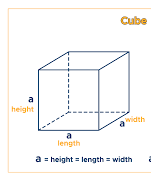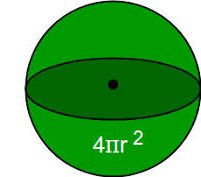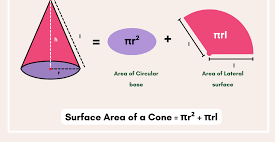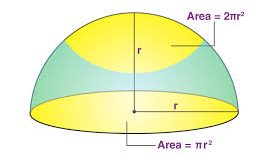Surface Area Formula
The formula of surface area is a way to find out how much space is on the outside of a shape or object. It adds up the area of all the outer sides. Different shapes have different formulas. For example, for a cube, it’s 6a2, and for a sphere, it’s 4πr2. Using the correct formula helps you measure wrapping paper, paint, or covering materials.
Surface Area Formulas
Surface area formulas are different rules used for finding the outer area of 3D shapes. Each shape cube, cuboid, sphere, cone, or cylinder has its own specific formula. Learning these formulas makes it easier to answer math problems or solve real-life tasks like painting walls or making product packages.
But why is it important?
Whether it’s figuring out how much wrapping paper is needed for a gift box or how much paint to cover a ball, surface area helps solve everyday problems in fun and creative ways. In this blog, we will discuss the surface area formulas of different three-dimensional geometrical shapes.
What is Surface Area?
Surface area is the total outer area of a three-dimensional object, describing the space its surfaces occupy. It is used by designers, engineers, and architects to calculate materials for wrapping, painting, or construction.
Measured in square units like cm² or m², surface area has two types:
Lateral Surface Area (LSA): This measures the area of the vertical or curved sides of an object. It excludes the top and bottom faces. For example, the label around a cylindrical can represents its lateral surface area.
Total Surface Area (TSA): This includes the area of all surfaces of the object, covering the top, base, and sides. It represents the complete outer area. For instance, the entire outer covering of a box is its total surface area.
These types ensure clarity when calculating specific areas of a three-dimensional figure.
Surface Area Formulas
Surface area formulas are used to calculate the total surface area, which includes all surfaces (base and sides), and the lateral surface area, which covers only the sides. Below is a table of important surface area formulas for various three-dimensional figures.
|
Surface Area Formulas
|
| Shape |
Lateral Surface Area (LSA) |
Total Surface Area (TSA) |
| Cube |
4a 2 |
6a 2 |
| Cuboid |
2h(l+b) |
2(lb + lh + bh) |
| Cylinder |
2πrh |
2πr(r + h) |
| Cone |
πrl |
πr(l + r) |
| Sphere |
4πr 2 |
4πr 2 |
| Hemisphere |
2πr 2 |
3πr 2 |
| Pyramid |
1/2 × (Base Perimeter) × (Slant Height) |
Lateral Surface Area + Area of Base |
Surface Area of Different Geometrical Shapes
Here, we will discuss the meaning of the surface area of different three-dimensional geometrical shapes, including cubes, spheres, cylinders, cuboids, cones, and pyramid along with their formulas and examples to understand their practical applications.
Surface Area of Cube
The surface area of a cube is the total area covered by its six square faces. A cube is a 3D geometric shape where all sides are equal and each face is a square. The surface area of a cube is expressed in terms of square units (e.g., cm 2 ,m 2 ,in 2 ) 
There are two types of surface areas for a cube:
- Total Surface Area (TSA
- Lateral Surface Area (LSA)
T otal Surface Area (TSA) of a Cube: The total surface area of a cube is the combined area of all six square faces. Since each face is a square with equal sides, the total surface area can be calculated by summing up the areas of all six faces.
TSA of Cube Formula = 6a 2 Where a is the length of one side of the cube. Lateral Surface Area (LSA) of a Cube: The lateral surface area of a cube refers to the total area of its four vertical faces, excluding the top and bottom faces. Each lateral face is a square, and since there are four of them, the lateral surface area is four times the area of one square face. LSA of Cube Formula = 4a 2 Where a is the side length of the cube.
Surface Area of Cube Example
Find the total and lateral surface area of a cube with a side length of 8 cm.
Solution:
Given Data:
Side of the cube ( a ) = 8 cm
Step 1: Total Surface Area (TSA)
The formula for the total surface area of a cube is:
TSA = 6a 2
Substitute the given side length:
TSA = 6×(8) 2 = 6 × 64 = 384 cm 2
Step 2: Lateral Surface Area (LSA)
The formula for the lateral surface area of a cube is:
LSA = 4a 2
Substitute the given side length:
LSA = 4 × (8) 2 = 4 × 64 = 256 cm 2
Surface Area of Cuboid
The surface area of a cuboid refers to the total area covered by all of its surfaces. Since a cuboid is a 3D form of a rectangle, its surface area depends on its length, breadth, and height. A cuboid has two main types of surface areas. They are:
- Total surface area of a cuboid
- Lateral surface area of a cuboid
Total Surface Area (TSA): T he total surface area of a cuboid is the sum of the areas of all six rectangular faces. Since opposite faces are equal, it can be calculated as: TSA of Cuboid Formula: 2(lb + bh + lh) square units Where l is the length, b is the breadth, and h is the height of the cuboid. Lateral Surface Area (LSA): The lateral surface area refers to the area of the four vertical faces, excluding the top and bottom faces. It is calculated as: LSA of Cuboid Formula: 2h(l + b) square units
Surface Area of Cuboid Examples
Example 1: Determine the lateral surface area of a cuboid with the following dimensions:
- Length ( l ) = 18 in
- Breadth ( b ) = 10 in
- Height ( h ) = 14 in
Solution:
We know the formula for the lateral surface area of a cuboid:
LSA = 2h(l + b)
Step 1: Substitute the given values into the formula:
LSA = 2 × 14 × (18 +10)
Step 2: Simplify:
LSA = 2 × 14 × 28 = 2 × 392 = 784 square inches
The lateral surface area of the cuboid is 784 square inches .
Example 2: Find the total surface area of a cuboid with the following dimensions:
- Length ( l ) = 20 cm
- Breadth ( b ) = 12 cm
- Height ( h ) = 10 cm
Solution:
We know the formula for the total surface area of a cuboid:
TSA = 2(lb + bh + hl)
Step 1: Substitute the given values into the formula:
TSA = 2 × [(20 × 12) + (12 × 10) + (10 × 20)]
Step 2: Simplify each term
TSA = 2 × [240 + 120 + 200] = 2 × 560 = 1120 square cm. The total surface area of the cuboid is
1120 square cm
Surface Area of a Sphere
.

The surface area of a sphere represents the total area occupied by its surface.
Example: Find the surface area of a sphere with a radius of 7 cm. The formula is Surface Area of Sphere is = 4πr 2 Substituting r = 7 Surface Area = 4 × 3.14 × 7 2 = 615.4 cm 2 Thus, the surface area of the sphere is 615.4 cm² .
Curved Surface Area (CSA) of a Sphere
Since the sphere has only one curved surface, the curved surface area equals the total surface area: CSA = 4πr 2
Total Surface Area (TSA) of a Sphere
The TSA is the same as the CSA, as the entire sphere is curved: TSA = CSA = 4πr 2
Surface Area of Hemisphere
The surface area of a hemisphere refers to the total area covered by its surfaces. A hemisphere can be either solid or hollow , and its surface area is calculated in two parts:
Substituting the formulas: TSA of Hemisphere = 2πr 2 + πr 2 = 3πr 2
Surface Area of a Hemisphere Example
Find the curved surface area (CSA) and total surface area (TSA) of a hemisphere with a radius of 5 m.
Solution:
Given:
r = 5 m (radius)
Step 1: Curved Surface Area (CSA)
The formula for the curved surface area is: CSA = 2πr 2
Substitute the values:
CSA = 2 × 3.14 × 5 2
Simplify:
CSA = 2 × 3.14 × 25 = 157 sq.
Step 2: Total Surface Area (TSA)
The formula for the total surface area is: TSA = 3πr 2 Substitute the values: TSA = 3 × 3.14 × 5 2
Simplify:
TSA = 3 × 3.14 × 25 = 235.5 sq. m
Surface Area of Cylinder
The surface area of a cylinder is the total area of its outer surface, which includes the curved (side) surface and the areas of its two circular bases. Imagine a cylinder-shaped object, like a can of soda.
Curved Surface Area Formula: 2πrh Total Surface Area (TSA): The total surface area is the sum of the curved surface area and the areas of the two circular bases. Each base has an area of πr 2 ,and there are two bases.
Total Surface Area Formula: 2πr 2 + 2πrh = 2πr(r+h)
Surface Area of a Cylinder Example
Find the total and lateral surface area of a cylinder with a radius of 14 cm and a height of 28 cm.
Solution:
Given:
- r = 14 cm (radius)
- h = 28 cm (height)
Step 1: Lateral Surface Area (LSA)
The formula for lateral surface area is: LSA = 2πrh
Substitute the values:
LSA = 2 × 22/7 × 14 × 28
Simplify:
LSA = 2 × 22 × 2 × 28 = 2464 sq. cm
Step 2: Total Surface Area (TSA)
The formula for total surface area is: TSA = 2πr 2 + 2πrh
Substitute the values:
TSA = 2 × 22/7 × 14 2 + 2 × 22/7 × 14 × 28
Simplify the first term ( 2πr 2 ):
2 × 22/7 × 14 2 = 2 × 22/7 × 196 = 1232 sq. cm
Simplify the second term ( 2 π r h ):
2 × 22/7 × 14 × 28
Simplify
2 × 22 × 2 × 28 = 2464 sq. cm
Add the two terms:
TSA = 1232 + 2464 = 3696 sq. cm
Surface Area of a Cone

The surface area of a cone is the total area covered by its boundary, which includes the curved surface area (CSA) and the total surface area (TSA).
CSA = πrl
Where r is the radius of the base, and l is the slant height of the cone.
Total Surface Area (TSA): The TSA represents the combined area of the curved surface and the circular base.
TSA = πrl + πr 2
Here, r is the radius of the base, and l is the slant height.
Surface Area of a Cone Example
Find the total surface area and curved surface area of a cone if its radius is 12 cm and its slant height is 16 cm. (Use π=3.14 )
Solution:
Given:
- Radius of cone ( r ) = 12 cm
- Slant height ( l ) = 16 cm
Step 1: Curved Surface Area (CSA)
The formula for the curved surface area of a cone is:
CSA = πrl
Substitute the values:
CSA = 3.14 × 12 × 16
Simplify:
CSA = 602.88 sq. cm
Step 2: Total Surface Area (TSA)
The formula for the total surface area of a cone is:
TSA= πr(r+l)
Substitute the values:
TSA = 3.14 × 12 × (12 + 16)
Simplify:
TSA = 3.14 × 12 × 28 TSA = 3.14 × 336 = 1,055.04 sq. cm.
Surface Area of a Pyramid
The surface area of a pyramid is the total area covering its outer surface, including the areas of its triangular side faces (lateral surfaces) and the base. The formulas differ depending on the type of pyramid, but the general process remains the same. 
Lateral Surface Area (LSA): The sum of the areas of the triangular side faces.
Lateral Surface Area Formula: 1/2×Perimeter of Base (P)×Slant Height (l) square units
Total Surface Area (TSA): The sum of the lateral surface area and the area of the base.
Total Surface Area Formula: = LSA + Area of Base square units
Surface Area Formulas for Specific Pyramids
The following table summarizes the lateral surface area (LSA) and total surface area (TSA) formulas for different types of pyramids. It also includes the key parameters needed for each calculation.
| Pyramid Type |
Lateral Surface Area (LSA) |
Total Surface Area (TSA) |
Key Parameters |
| Triangular Pyramid |
1/2×P×l |
1/2×P×l+1/2×b×h |
P : Perimeter of the triangular base b : Base of the triangle h : Height of the triangle l : Slant height of pyramid |
| Square Pyramid |
2al |
2al+a 2 |
a : Side length of the square base l : Slant height of pyramid |
| Rectangular Pyramid |
Sum of areas of all triangular faces |
LSA+l×w |
l : Length of the rectangular base w : Width of the rectangular base |
| Pentagonal Pyramid |
5/2×s×l |
5/2×s×l+5/2×a×s |
s : Side length of the pyramid a : Apothem length of the pentagonal base l : Slant height of the pyramid |
| Hexagonal Pyramid |
3s×l |
3s×l+3√3/2 s 2 |
s : Side length of the hexagonal base l : Slant height of the pyramid |
Surface Area of a Pyramid Example















